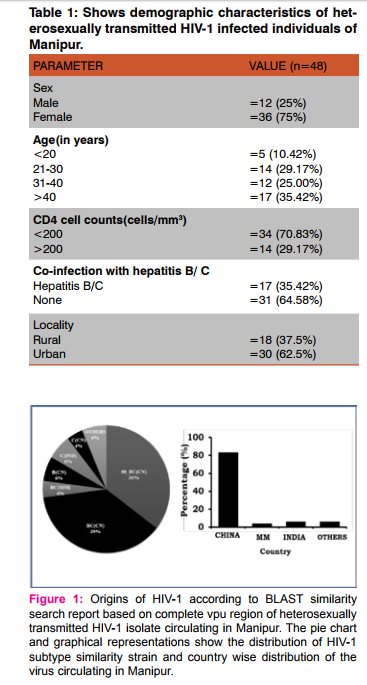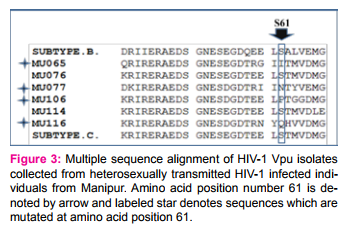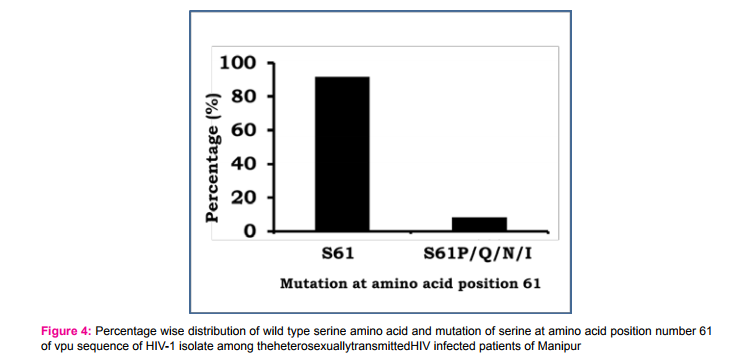IJCRR - 7(5), March, 2015
Pages: 24-29
Print Article
Download XML Download PDF
ANALYSIS OF VIRAL PROTEIN U VARIANT AT AMINO ACID POSITION 61 AMONG THE HETEROSEXUALLY TRANSMITTED HIV-1 PATIENTS OF MANIPUR
Author: Adhikarimayum Lakhikumar Sharma, Thiyam Ramsing Singh, Khuraijam Ranjana Devi, Lisam Shanjukumar Singh
Category: Healthcare
Abstract:Background: Mutation at amino acid position 61 of vpu influences the stability, release and toxicity of the HIV-1. Previously, we have reported that the seryl residue 61 of HIV-1 was mostly conserved among the HIV-1 infected Intravenous Drug Users (IDUs) of Manipur. In this study, we further analyzed the site mutagenesis at seryl residue 61 among the heterosexually transmitted HIV-1 infected individuals of Manipur. Methodology: Heterosexually transmitted HIV-1 infected blood samples from forty eight individuals have been studied by viral amplification and sequencing at vpu gene of HIV-1. Translated amino acid sequences were aligned with reference strain of HIV- 1 for analysis of amino acid variation at position number 61. Phylogenetic tree were also interfered among the studied sample. Results: The results revealed that 91.67% of heterosexually transmitted HIV-1 infected individuals were harboring virus with conserved seryl residue 61 which has viral-enhancement function while only 8.33% harbored mutated virus. Phylogenetic tree of the vpu sequences among the heterosexually transmitted HIV-1 infected individuals of Manipur displayed multiple clusters. Conclusions: Among the heterosexually transmitted HIV-1 infected individuals of Manipur, vpu is highly conserved at amino nacid position 61 with serine (wild-type) which predicts virus to be more virulent. The analysis also indicated that the heterosexually transmitted virus was possibly introduced from multiple sources. The understanding developed on HIV-1 pathogenicity will provide vital information for the policy makers and clinicians for sentinel surveillance of this pandemic and may help the vaccine/ drug developers to design effective anti-HIV-1 therapeutic agents to fight back the deadly AIDS pandemic.
Keywords: HIV, Heterosexual, vpu, Manipur, AIDS, India
Full Text:
INTRODUCTION
HIV/AIDS is a life-threatening disease and remains a threat to all over the world. In India, HIV/AIDS related case was detected for the first time in the year 1986(1). Four year later, in February 1990, the HIV/AIDS was reported in Manipur, a northeastern state of India, for the first time from a blood sample of an intravenous drug user collected on October 1989(2). Since then, Manipur is one of three epicenters of the HIV/AIDS epidemic in India, and arguably the fastest growing. Initially, the progress of HIV epidemic was relatively slow but over the years the number of HIV infected individuals increased and it is a major public health problem now. Manipur is an important gateway of India to “golden triangle” of Southeast Asia, the second largest opium producer in the world where illicit drugs are commonly available(3). Easy available of heroin (locally call as “number four”), an injecting drugs used in Manipur, from the major trafficking route have led to mass uses of these injecting drugs among the youth of this region(4-6). Youths during early 1980’s were commonly addicted to injecting drugs, share injecting equipment and exposing themselves of contracting the deadly virus. The HIV-1 infection was once dominated among IDUs in Manipur(7). In sparsely populated, HIV transmission in Manipur was earlier associated with the sharing of HIV infected needles among the Injecting drug users(8). However, the HIV/AIDS epidemic in Manipur has now penetrated into the general population including children through risk behaviors of IDUs. Manipur, a small state with hardly 0.2% of India’s population, has contributed the highest HIV prevalence approximately 8% of India’s total HIV positive cases(7). According to National AIDS Control Society (NACO) annual report 2013-2014, the epidemiological indices of HIV-1 in this region was estimated to be 1.22% among the adult HIV prevalence and out of 51,583 general clients tested for HIV positive, 1,536 are found to seropositive with HIV-1 (9). The pathogenesis of HIV infection is different from other primate lenti-viruses. It induces immunodeficiency, the pathological hallmark of HIV infection caused by severe depletion of infected as well as uninfected lymphocyte populations. HIV-1 has three main gene gag, pol and env genes along with six accessory gene(10). Vpu gene is one of accessory gene and hallmark features of HIV- 1. Vpu (16-kd, 81-amino acid) is a type I integral membrane protein consisting of a short N-terminal domain, a single transmembrane a-helix domain, two cytosolic α-helices separated by a flexible connector loop, and a short C-terminal tail(11, 12). It has two different biological functions (a) cytoplasmic domain (CTD): degradation of CD4 and (b) transmembrane domain (TMD): enhancement of virion release(13). Moreover, vpu locus is considered as one of the most variable regions in HIV-1 genome. Replacement of serine at position 61 (S61) with alanine was associated with a significant increase in p24 production, confirming that S61 contributes to the viralenhancement function of this particular viral strain(14, 15). Viral releases as well as apoptosis were influenced by mutation at S61 (14, 16). In continuation to our previous mutational study among the IDUs of Manipur(17), the variability of HIV-1 vpu was further investigated among the heterosexually transmitted HIV-1 infected individuals of Manipur.
MATERIAL AND METHODS
Ethics Statement
Written informed consent was obtained from each participant involved in the study. This study was reviewed and approved by Institutional Human Ethical Committee (IHEC), Manipur University (MU) and Regional Institute of Medical Science (RIMS).
Study Subjects
Forty eight heterosexually transmitted HIV-1-positive individuals from Manipur were recruited for the study. Participants were counseled individually and allowed to sign voluntary the informed consent form before the sample collection. All the samples were collected from Regional Institute of Medical Science (RIMS) where the participants from different district of Manipur have been registered at the Anti-retroviral therapy (ART) Centre. All enrolled patients had previously received antiviral treatments. Two milliliters (2ml) of whole blood drawn from each participant’s veins was collected in an EDTA Vacutainer (Becton Dickinson, USA). Blood samples were collected in the year 2012-2013.
DNA Extraction
Peripheral Blood Mononuclear Cells (PBMCs) were separated from whole blood samples by Ficoll–hypaque (GE healthcare, USA) gradient centrifugation method as per manufacturer’s instructions. PBMCs were used to extract genomic DNA using QIAamp DNA blood mini kit (Qiagen GmbH, Germany), according to the manufacturers’ protocol. Genomic DNA was analyzed on 0.8% agarose gel to check the integrity prior to viral gene amplification.
Viral Gene Amplification:
The complete vpu region of HIV-1 genome was amplified from genomic DNA by nested polymerase chain reaction (PCR) technique using high fidelity Taq polymerase (Invitrogen, USA) with forward primer (MUHIVVF1: 5’- AGARGAYAGATGGAACAAGCCCCAG - 3’) and reverse primer (MUHIVVR1: 5’- GTGTGTAGTTCTGCCAATCAGGGAA- 3’) in the first round PCR and forward primer (MUHIVVF2: 5’- TGGAAGCATCCRGGAAGTCAGCCT- 3’) and reverse primer (MUHIVVR2: 5’- GGTACCCCATAATAGACTGTRACCCACAA- 3’) in the second round PCR(18). PCR reactions were carried out in 50µL final volumes containing 250µM dNTPs, 200nM of each primer, 2mM of MgCl2 , 1µg genomic DNA and 6U of Taq polymerase. Cycling parameters were one cycle of denaturation at 94o C for 5 minutes and then add 6U of PCR enzyme as a manual hot-start; followed by 10 cycles of: 94o C for 30s, 60o C for 30s, and 68o C for 45s; then 20 cycles of: 94o C for 30s, 55o C for 30s and 68o C for 45s; one final extension at 68o C for 10 minutes. Identical conditions were used for the pre-nested PCR except for cycling extension for 4mins.
DNA Purification and Sequencing:
The amplified products were electrophoresed onto a 2.0 % agarose gel, stained with ethidium bromide and evaluated under UV light. Desired PCR products were excised and purified for sequencing by using the QIA quick PCR purification kit (Qiagen GmbH, Germany) according to the manufacturer’s protocols. Sequencing of PCR products was performed with an ABI PRISM 3730XL DNA Analyzer using Big Dye terminators (Applied Biosystems, Foster City, California, USA).
Sequence Comparison and Phylogenetic tree construction:
The nucleic acid sequences were analysed using HIV Blast (http://blast.ncbi.nlm.nih.gov/Blast.cgi) to search similarity of the sequences with previously reported ones. The nucleic acid sequences were translated into amino acid sequences and aligned with reference sequences by the ClustalW method under BioEdit software (BioEdit software version 7. 1.11), followed by manual adjustment. Reference sequences were retrieved from the Los Alamos National Laboratory HIV Sequence Database (http://www.hiv.lanl.gov). Phylogenetic analyses were interfered using the Maximum Likelihood tree and method/model based on the Kimura 2-parameter distance matrix and bootstrap method (1000 replicates) of test phylogeny, using MEGA software (Version 6.0).
RESULT
Study Population: In this study, 48 heterosexually transmitted HIV-1-positive patients, including 12 males and 36 females from different district of Manipur, were recruited during 2012- 2013. All the males used in study were infected due to multiple sex partners while all the females used in study were either wives of IDUs or female sex workers (FSWs). All the participants had received antiviral treatments. The median age of the participants was 32 years. 35.42% (17/48) were co-infected with hepatitis B/or C (Table 1).
Origin and Phylogenetic analysis:
According to BLAST similarity search, most of the sequences of vpu regions isolated from heterosexually transmitted HIV-1 infected individuals were found to have the best match with sequences originated from China. The results revealed that 84% (40/48) showed highest similarity score with the HIV-1 variants originated from China, 6% (3/48) were originated from India, 4% (2/48) were originated from Myanmar and 6% (3/48) were originated from other countries Zambia, Kenya (Figure 1). Phylogenetic tree of the vpu sequences among the heterosexually transmitted HIV-1 infected individuals of Manipur displayed multiple clusters (Figure 2). The analysis indicated that the heterosexually transmitted virus was possibly introduced from multiple sources.
VPU variants among the heterosexually transmitted HIV
Among the heterosexually transmitted HIV-1 infected individuals, 91.67% (44/48) were found to be harboring virus with conserved seryl residue at amino acid position 61 of vpu gene while only 8.33% (4/48) were found to harbor virus with mutation at the amino acid position number 61. Four individuals (Sample ID: MU065, MU077, MU106 and MU116) display amino acid substitutions at position number 61 by isoleucine, asparagine, glutamine and proline respectively (Figure 3 and 4).Moreover, due to the extensive polymorphisms the size of the open reading frame (ORF) of vpu variants was differently displayed. Most of them showed unique transmembrane and cytoplasmic deletions which may have functional implications with respect to various vpu mediated functions.
DISCUSSION
Manipur which located near China-Myanmar-India border region is an interesting area for illegal drug trafficking from the “Golden triangle” to other countries/ regions and has very high prevalence of HIV-1 and other viruses (e.g. HCV and HBV)(8, 19). The present study is the continuation of our previous mutational study of vpu to predict the pathogenicity of virus among the HIV- 1 infected population of Manipur(17). The study site shares about 90% of its entire border area with China, Myanmar, Bangladesh, and Bhutan, whereas only about 10% share with mainland India and is one of highest HIV prevalence in the country. The main obstacle to control HIV is due to its ability to accumulate mutations in all its genes in the infected individuals. These mutants are continuously generated and infect new host cells. HIV- 1 encodes a small integral membrane vpu protein and has no homolog HIV-2 virus (less pathogenic)(11, 20). Vpu locus is considered one of the most variable regions in HIV-1 genome and these variations play a major role in controlling viral release as well as apoptosis, both of which are important for HIV-1 pathogenesis. It was previously reported that variation at serine 61 determined the virus pathogenicity by controlling viral release as well as apoptosis. According to published data, seryl residue substitution to alanine at amino acid position 61 in vpu variants showed enhanced intracellular expression and intracellular stability(16). Analysis of vpu sequences among the heterosexually transmitted HIV-1 infected individuals reveal that 91.67% (44/48) harbor virus with highly conserved seryl residue at amino acid position number 61while only 8.33% (4/48) harbors mutated virus with the substitution of serine at amino acid position 61 by isoleucine, asparagine, glutamine and proline. Moreover, our study also suggested that the vpu sequences of HIV found in northeastern region of India were closely similar to HIV- 1 strains of China, mainland India, Myanmar and other countries indicating that heterosexually transmitted virus circulating in Manipur was possibly introduced from multiple sources.
CONCLUSION
The overall finding of this study reveals that among the heterosexually transmitted HIV-1 infected individuals of Manipur, vpu is highly conserved at amino acid position 61 with serine (wild-type) which has been predicted virus to be more virulent. The understanding developed on HIV-1 pathogenicity will provide vital information for the policy makers and clinicians for sentinel surveillance of this pandemic and may help the vaccine/drug developers to design effective anti-HIV-1 therapeutic agents to fight back the deadly AIDS pandemic. Accession Numbers The GenBank accession numbers are KM359881, KM359886, KM359888, KM359870-KM359872, KM359919-KM359928 and KM359930-KM359960.
Ethical: Institutional Human ethical committee (IHEC) (Reference no- Ac/112/EC/RIMS/2005 of 25th July 2010) by Regional Institute of Medical Science (RIMS) and Manipur University (MU) approved this study.
Conflict of interest: The authors declare that there are no conflicts of interest. Authors’
Contributions: ALS carried out the molecular biology work and subsequent analysis; KRD provided the samples; LSS and TRS conceived, designed and supervised the study. All authors have approved the final manuscript.




References:
1. Simones EA BP, John TJ, Nirmala S, Solomon S , et al. Evidence for HTLV-III infection in prostitutes in Tamil Nadu (India). Indian J Med Res. 1987;85:335-8.
2. (MACS) MACS. Annual Report. 2008.
3. United Nation Office on Drugs and Crime (UNODC). South East Asia Survey 2013. 2013.
4. Eicher AD, Crofts N, Benjamin S, Deutschmann P, Rodger AJ. A certain fate: spread of HIV among young injecting drug users in Manipur, north-east India. AIDS Care. 2000;12(4):497-504.
5. Chandrasekaran P, Dallabetta G, Loo V, Rao S, Gayle H, Alexander A. Containing HIV/AIDS in India: the unfinished agenda. Lancet Infect Dis. 2006;6(8):508-21.
6. Kermode M, Longleng V, Singh BC, Hocking J, Langkham B, Crofts N. My first time: initiation into injecting drug use in Manipur and Nagaland, north-east India. Harm Reduct J. 2007;4:19.
7. About AIDS in Manipur. national informatics centre, porompat 795005, http://imphaleastnicin/aidshomehtm#a.
8. Chris Beyrer MHR, Khomdon Lisam, Jei Chen, Wei Lui and Xiao-Fang yu. Overland heroin traficking routes and HIV-1 spread in south and south east asia. AIDS 2000. 1999;14:75-83.
9. National AIDS Control Society (NACO) DoACMoHFW, Government of India. Annual Report 2013-2014. 2014.
10. Cullen BR, Greene WC. Functions of the auxiliary gene products of the human immunodeficiency virus type 1. Virology. 1990;178(1):1-5.
11. Cohen EA, Terwilliger EF, Sodroski JG, Haseltine WA. Identification of a protein encoded by the vpu gene of HIV-1. Nature. 1988;334(6182):532-4.
12. Matsuda Z, Chou MJ, Matsuda M, Huang JH, Chen YM, Redfield R, et al. Human immunodeficiency virus type 1 has an additional coding sequence in the central region of the genome. Proc Natl Acad Sci U S A. 1988;85(18):6968- 72.
13. Nomaguchi M, Doi N, Fujiwara S, Fujita M, Adachi A. SiteDirected Mutagenesis of HIV-1 vpu Gene Demonstrates Two Clusters of Replication-Defective Mutants with Distinct Ability to Down-Modulate Cell Surface CD4 and Tetherin. Front Microbiol. 2010;1:116.
14. Estrabaud E, Le Rouzic E, Lopez-Verges S, Morel M, Belaidouni N, Benarous R, et al. Regulated degradation of the HIV-1 Vpu protein through a betaTrCP-independent pathway limits the release of viral particles. PLoS Pathog. 2007;3(7):e104.
15. De Candia C, Espada C, Duette G, Salomon H, Carobene M. Human immunodeficiency virus-1 BF intersubtype recombinant viral protein U second alpha helix plays an important role in viral release and BST-2 degradation. J Gen Virol. 2013;94(Pt 4):758-66.
16. Verma S, Ronsard L, Kapoor R, Banerjea AC. Genetic characterization of natural variants of Vpu from HIV-1 infected individuals from Northern India and their impact on virus release and cell death. PLoS One. 2013;8(3):e59283.
17. Sharma AL Singh TR, Machathoibi TC, Singh S D, Devi KR and Singh LS. Genetic study of vpu variant among the HIV-1 infected intravenous drug users of Manipur predicts highly pathogenic virus. IIJSR. 2014;vol 1(no.2):106-12.
18. Nadai Y, Eyzaguirre LM, Constantine NT, Sill AM, Cleghorn F, Blattner WA, et al. Protocol for nearly full-length sequencing of HIV-1 RNA from plasma. PLoS One. 2008;3(1):e1420.
19. Sibnarayan Datta AB, Partha K. chandra, pradip K. Mahapatra, Shekhar Charabarti and Runu Chakravarty.Drug Trafficking Routes and Hepatitis B in Injecting Drug users, Manipur, india. Emerging Infectitious Disease. 2006;12(12):1954-7.
20. Strebel K, Klimkait T, Martin MA. A novel gene of HIV-1, vpu, and its 16-kilodalton product. Science. 1988;241(4870):1221-3.
|






 This work is licensed under a Creative Commons Attribution-NonCommercial 4.0 International License
This work is licensed under a Creative Commons Attribution-NonCommercial 4.0 International License